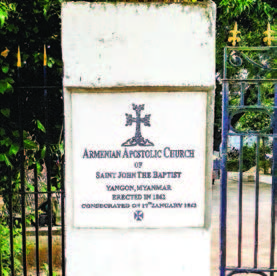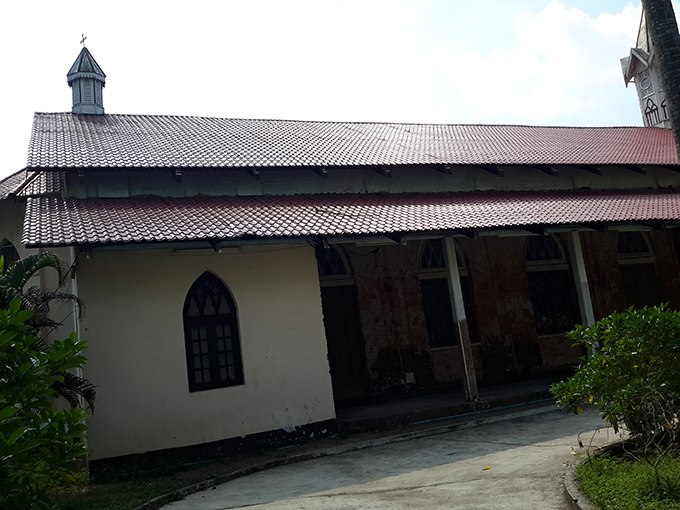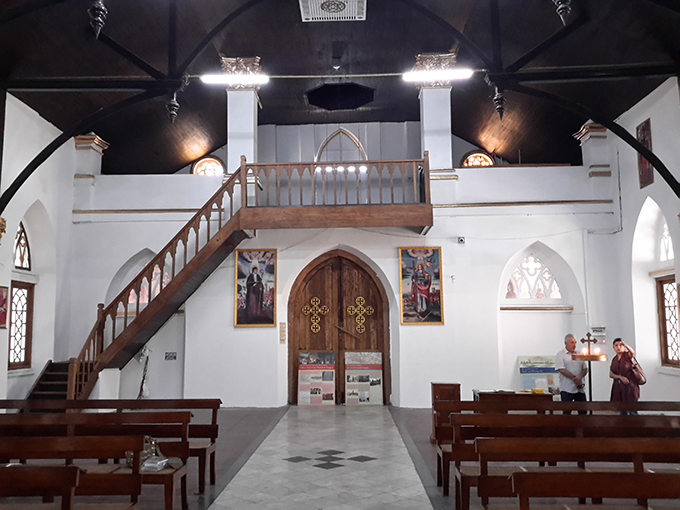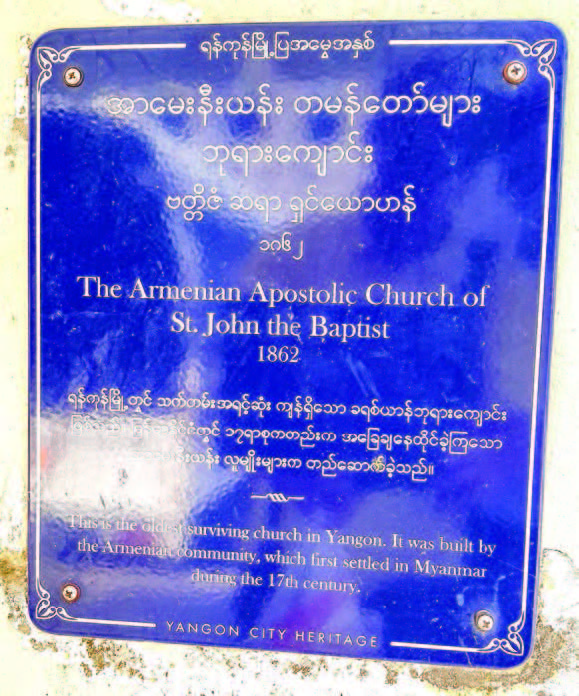March 28, 2020
By Maung Tha (Archaeology)
The Law on the Preservation and Protection of Ancient Buildings mentioned that the buildings of more than 100 years old are involved on the list of ancient structures. Among more than 100 years old ancient buildings in various regions of the country, most of the buildings established in colonial era can be seen in Yangon City.
British constructed residential houses, offices and religious buildings in Yangon City after occupying Myanmar. These buildings are included on the list of ancient buildings at present. Among them, the Armenian Orthodox Church, 157 years old, is the longest life Christian church in Yangon.

Yangon in the history
Mon ethnic people established a fishery village named Dagon in the place of present Yangon between 1028 AD and 1043 AD. King U Aung Zeya who was the first king in Konbaung era came onto the throne in 1752 AD and established new Yangon city on 75 acres of land in the area of Dagon Village on 2 May 1755 with appointment of a city governor.
British occupied lower Myanmar on 20 December 1852 when Konbaung era had been established for 100 years. In 1853, Dr W Montgomery and Lt A Fraser drew an urban plan for implementation of modern Rangoon plan centring Sule Pagoda so as to establish the lower Myanmar.
According to the Reconstruction of Modern Rangoon 1853, Yangon City was established in the shape of chess board pattern. The area of Yangon City was limited on East Road called current Theinbyu Street in the east, Lanmadaw Road in the west, Strand Road in the south and Commissioner Road called Bogyoke Aung San Street at present in the north. Yangon City consisted of five main roads with 180 feet each in width (now Strand Road, Merchant Street, Maha Bandoola Street, Anawrahta Street and Bogyoke Aung San Street) which stretched from the east to the west and the streets under numbers from the south to the north. The west street of Yangon City was 17th street and the east one, 44th street. Many buildings including Christian churches were established in that area.

Armenian Orthodox Church
After establishment of modern Yangon City, the Armenian Orthodox Church facing Merchant Street was built on the land plot at the corner of Merchant Street and Bo Aung Kyaw Street in current Kyauktada Township in 1862. The Orthodox Church built as the earliest Christian missionary church in Yangon has been hosting the religious services till today.
Currently, some 20 members of Armenian families residing in Yangon City attend the holy services at the church on Sundays twice a month. Sometimes, when the father from the church is busy, the church postpones hosting the service on Saturday instead of Sunday. At present, there may be about 100 persons of Armenian across Myanmar, said Mr. Steven who guards the church.
Armenians and their relatives who arrive in Yangon for many reasons come to the Armenian Orthodox Church for joining the services.
The Armenian cemetery where bodies of Armenians in Yangon were cremated was located near Jew Cemetery, Islam Cemetery and Christian Cemetery nearby Yangon Railway Station from 1874 to 1980. Now, the cemeteries did not exist there. Mr. Martitossian, one of the Armenians in Yangon, passed away in 2013.
After Portuguese citizens had entered Myanmar, Armenians settled in Thanlyin in 17th century AD to do trading. An ancient Portuguese Church was built at the entrance to Thanlyin in 1749 with the contribution of an Armenian. Some people misunderstood that the tomb in the compound of the church was that of Portuguese Na Zin Kar. Actually, it was the tomb of Armenian citizen Nicolas de Agualar who was buried in 1750. The inscriptions on the tomb were described in Portuguese, Latin and Armenian languages.
Myanmar and Armenians
Armenia is a landlocked country in Caucasus and Eurasia region, teeming with jungles and hills. It was Armenian Soviet Socialist Republic of past Soviet Union but it seceded from the Soviet Union on 23 August 1990 to establish the First Republic of Armenia. Armenians enacted Christianity as State religion in 301 AD.
Khojas, the Armenian merchants, wondered around the world by trading with partners through land route and waterway. They arrived in Myanmar in early 1550. In the reign of Myanmar kings, they served at Inwa Royal Palace while other Armenians who did not serve the Myanmar king were wealthy by doing businesses in some towns and villages in Myanmar including Amarapura, Mandalay and Yangon.
Henry Yule accompanying the diplomatic delegation led by Major Arthur Phayre who paid a trip to Inwa Royal Palace in upper Myanmar from Yangon of lower Myanmar on 1 August 1855 compiled and published a record of British diplomatic delegation to Inwa.
The record mentioned Armenians had visited Myanmar’s royal palace for many years. Twelve families of Armenians resided in Amarapura. Armenian citizen Makertich J Mines, Malun governor of Myanmar king, welcomed the British diplomatic delegation in Malun to the royal palace. Number of Armenians in Myanmar increased to 1,250 in 1871-1872, up from 40 in 1804.

Armenian entrepreneurs in Yangon City
Armenian merchants Khojas arriving at Yangon were wealthy because of successfully doing businesses.
The Strand Hotel in Yangon City was bought by two Armenian brothers Sarkies in 1901, and they operated the hotel till 1925. Likewise, Armenian Myanmar Pete Arratoon owned the Silver Grill restaurant on Bar Street (now Maha Bandoola Park Street) and Balthazar building on Bank Street. At that time, the Silver Grill restaurant was the best European style restaurant in Yangon.
The family of Armenian entrepreneur Balthazar contributed to erecting the Queen Vitoria Statue in the Fytche Square in 1896. The building of the present US embassy on Merchant Street was owned by Balthazar family.
Armenian engineers A C Martin and V J Nahapiet took responsibilities for construction of many buildings in colonial era including Bulloch Broths Building (now Yangon General Post Office) and Bank of Bangal (now Myanma Economic Bank Branch-3) in Yangon City. As such, the buildings installed with the plaque bearing the name of A C Martin can be seen till today, explained Ko Arkar Kyaw, a tour guide, who is studying Yangon City in colonial era.

Two Armenian Churches
Armenians started their settlements in Yangon in 18th century AD. As the first ever Armenian Church was built by Gregory Avas near Yangon River in 1766, the wooden tip roof of the church can be seen from far distance.
King Mindon allotted a land plot for the present church. After occupying Yangon, British allowed Armenians to continuously use the present church area free of charge while building the new city. Unfortunately, the First Armenian Church was destroyed by fire in 1850.
Hence, the Second Armenian Church was built and it was named St. John the Baptist. The church consecrated on 17 January 1863 was famous as Baptist Saint John Church. The church was built with the architectural works in the Middle Age of Europe. After completion of the construction, Father Aviet Chaytor arrived first at the church so as to manage holy services.
As the Yangon Heritage Trust-YHT put a blue plaque at the Armenian Church on 4 October 2014, His Holiness Catholicos Karekin II who came from the First Republic of Armenia unveiled the blue plaque which bears The Armenian Apostolic Church of the St. John the Baptist, 1862 in both Myanmar and English languages.
As YHT has been putting blue plaques at urban heritage buildings in Yangon City, the Armenian Orthodox Church was the third one of bearing the blue plaque as well as the first one among religious edifices in Yangon City.
On the same day, His Holiness Catholicos Karekin II and party served holy mass such as reading the Bible and praying at the Armenian Orthodox Church.
As efforts are being made to revitalize the Armenian faith because number of Armenians and its faith are lesser in Yangon, some persons join the faith, Mr Steven disclosed.
According to the Law on the Preservation and Protection of Ancient Buildings, the religious edifices including pagodas, stupas, temples, monasteries, brick monasteries, public rest house and ordination halls, the buildings related to the faiths and brick mounds are inclusive of ancient buildings.
As such, the Armenian Orthodox Church becomes one of the ancient buildings to be maintained and protected by the people.
The 157 years old Armenian Orthodox Church established in 1863 of colonial era is one of the historic urban heritages in Yangon City.
Translated by Than Tun Aung


